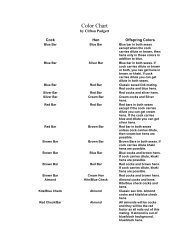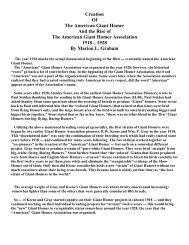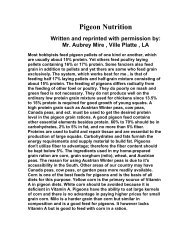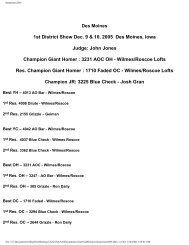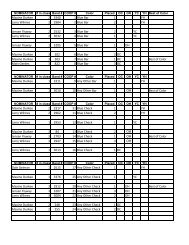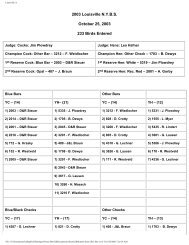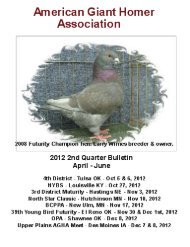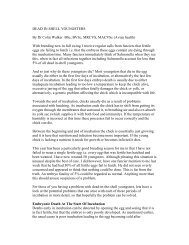Build a Family - American Giant Homer Association
Build a Family - American Giant Homer Association
Build a Family - American Giant Homer Association
You also want an ePaper? Increase the reach of your titles
YUMPU automatically turns print PDFs into web optimized ePapers that Google loves.
DO YOU NEED A FAMILY<br />
This is a question that may never have come to your mind. What do I mean by "Do you<br />
need a family" A family of pigeons! Over the years, many breeders buy, trade or borrow<br />
birds to use in their breeding program and most of the time the selection is done on<br />
looks, body or color.<br />
What I mean is to develop a family of pigeons that are, for the most, of the type we should<br />
be breeding toward and consistent in what they produce. If you look at your breeding<br />
records over a period of time and see that for the most part, your quality birds are<br />
coming out of two, three or four birds, those are your good producers.<br />
Some pair may raise eight or ten young and out of that bunch you may have one or two<br />
that make it to the show pen, these are not what you want to build a family around.<br />
I can remember in the past talking to several breeders and having them say this or that<br />
pair raised six or eight young and everyone of the young were being shown and 1 might<br />
end up high in their class.<br />
One such case is a hen that the boys in Arizona have that they call "The Sponge", and I<br />
think that the name has something to do with her soft body. Every year when I visit them,<br />
they will recount how many youngsters and grand-youngsters they have out of her and<br />
how well they did in the shows.<br />
Jack Anderson had a pair of birds that he bought at the Futurity Auction, old birds I think,<br />
that Denby Williamson donated. Every year for several years, Jack won consistently with<br />
youngsters from that pair.<br />
John Wagner always talks about the old Pohren cock that has fathered many, many of his<br />
winners. He can trace that cock back through many of his outstanding producers in his<br />
loft to this day.<br />
Dick and Georgianne Lausen often told me about one of the first pair they got , from Dick<br />
Bunkoske I think, that produced their best birds. I know that Georgianne still has birds<br />
from that pair in the breeding program.<br />
I once wrote an article that was titled "The Pair That Knicked". That was a term that we<br />
used in racing pigeons to refer to a pair that, when mated together, just seemed to hit it<br />
right in their gene pool. I had just such a pair of Racing <strong>Homer</strong>s and could count on the<br />
fact that when I had their young ready to ship to a race, they would be my first birds<br />
home.<br />
I can say that I have a hen that falls into that category. This hen just happened to come<br />
about. I offered a pair of birds to a new member under the Beattie Plan and he picked a<br />
Blue Bar cock that I bought from Randy Spahr and A Blue Check hen that I had bred<br />
myself. The new member decided after the breeding season that he did not want to<br />
continue with the <strong>Giant</strong> <strong>Homer</strong>s, so he brought the pair and the eight youngsters they<br />
raised back to me.
Out of the eight young, I kept five , as I thought they could make good show prospects. I<br />
gave the old Blue Check hen to John Wagner, and I believe he raised several young out<br />
of her. I ended up keeping the one cock youngster and one hen. Jack Anderson bought<br />
one hen at the Futurity and the Lausens bought another. Jack raised several good young<br />
and so did the Lausens; But I must say, my hen did great.<br />
The first year I mated her to a Grizzle cock from Lausen, and they produced two Grizzle<br />
Cocks, among other young. One of the Grizzle cocks I gave to Ben Jones, and the next<br />
year he won first at the Futurity in the Grizzle cock and hen class.<br />
I mated my Grizzle cock to a hen I bought from Curtis Reeves, and they produced several<br />
nice young, one of which was a Blue Check cock #4344, that was third in his class at<br />
Louisville and first in his class at the Futurity, along with being third reserve champion.<br />
This bird also won many more classes and two National Champions.<br />
I also mated the old Blue Check hen to a very good Opal Check cock in 1995 and kept an<br />
Opal Check hen. I mated the Opal Check hen to the Blue Check cock #4344, in 1996, and<br />
they produced five young. Two Opal Check cocks, one Opal Bar cock (that were second,<br />
third and fifth at the Futurity) and one Blue Check hen that was second at the Futurity.<br />
I have tried to mate the original Blue Check to a different cock every year and pick at<br />
least one of her young to put in my breeding program. The old hen has been one of those<br />
birds around which I feel you can develop a family.<br />
I do no want to leave you with the idea that if you find a bird like this, every youngster will<br />
be either a Champion or every youngster will produce a champion. I do believe that if you<br />
should happen onto a bird like this, breed as many as you can and with as many different<br />
mates as you can, to give you birds to inter-mate and strengthen the good genes.<br />
GEORGE LECHNER



